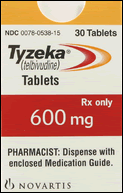Telbivudine
Label Adds Resistance Warning
| SUMMARY:
Package labeling for the hepatitis B drug telbivudine
(Tyzeka) was recently changed to add information about
the risk of drug resistance and a recommendation for monitoring
after 6 months of treatment. |
The
nucleoside analog telbivudine
has demonstrated good activity against hepatitis B virus (HBV),
but as with most drugs in its class, the virus can develop
drug resistance that compromises long-term efficacy.
Below
is the edited text of a recent advisory from the U.S. Food
and Drug Administration (FDA) describing label changes providing
more details about the risk of resistance and recommendations
for how to prevent it.
Labeling
Changes to Tyzeka (Telbivudine) 600 mg Tablets
and Oral Solution 100 mg/5 mL Reflect Risk of
Resistance-Associated Substitutions
April
1, 2011 -- FDA has approved changes in product labeling for
Tyzeka (telbivudine) 600 mg tablets and Tyzeka (telbivudine)
oral solution 100 mg/5 mL related to a higher risk of developing
resistance-associated substitutions in treated patients.
Indications and Usage-Under Section 1.1 Chronic Hepatitis
B
The following points should be considered when initiating
therapy with Tyzeka:
 |
For
HBeAg-positive patients, Tyzeka should only be initiated
in patients with HBV DNA less than 9 log10 copies/mL and
ALT greater than or equal to 2x Upper Limit of Normal
(ULN) prior to treatment. |
 |
For
HBeAg-negative patients, Tyzeka should only be initiated
in patients with HBV DNA less than 7 log10 copies/mL prior
to treatment. |
 |
On-treatment
response should guide continued therapy [see Dosage
and Administration (2.1) and Microbiology (12.4)].
|
Dosage
and Administration-Under Section 2.1 Adults and Adolescents
(16 years of age and older):
 Due
to higher rates of resistance that may develop with longer-term
treatment among patients with incomplete viral suppression,
treatment should only be initiated, if pre-treatment HBV DNA
and ALT measurements are known, in the following patient populations:
Due
to higher rates of resistance that may develop with longer-term
treatment among patients with incomplete viral suppression,
treatment should only be initiated, if pre-treatment HBV DNA
and ALT measurements are known, in the following patient populations:
For HBeAg-positive patients, HBV DNA should be less than 9
log10 copies/mL and ALT should be greater than or equal to
2x ULN prior to treatment with Tyzeka.
For HBeAg-negative patients, HBV DNA should be less than 7
log10 copies/mL prior to treatment with Tyzeka.
HBV DNA levels should be monitored at 24 weeks of treatment
to assure complete viral suppression (HBV DNA less than 300
copies/mL). Alternate therapy should be initiated for patients
who have detectable HBV DNA after 24 weeks of treatment. Optimal
therapy should be guided by further resistance testing.
Dosage and Administration-Under Section 2.4-Duration of
Therapy:
For patients with incomplete viral suppression (HBV DNA greater
than or equal to 300 copies/mL) after 24 weeks of treatment,
alternate therapy should be instituted. HBV DNA should be
monitored every 6 months to assure continued response. If
patients test positive for HBV DNA at any time after their
initial response, alternate treatment should be instituted.
Optimal therapy should be guided by resistance testing.
For more information on the role of Tyzeka in the treatment
of hepatitis, please see the American Association for the
Study of Liver Diseases (AASLD) Practice
Guidelines for Management of Chronic Hepatitis B.
4/5/11
Source
R Klein and K Struble (FDA). Labeling Changes to Tyzeka (Telbivudine)
600 mg Tablets and Oral Solution 100 mg/5 mL Reflect Risk
of Resistance-Associated Substitutions. FDA Hepatitis Update.
April 1, 2011.
